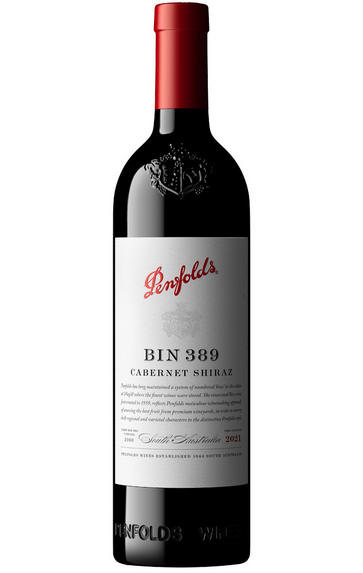
2021 Penfolds, Bin 389, Cabernet Shiraz, Australia
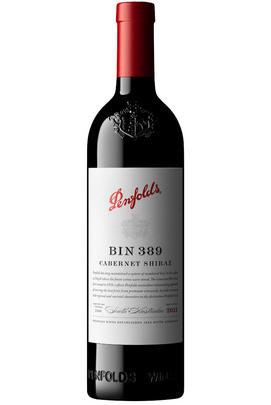
Critics reviews
53% Cabernet Sauvignon, 47% Shiraz from vineyards in McLaren Vale, Coonawarra, Barossa Valley, Wrattonbully and Padthaway. Overall, summer and autumn conditions were cooler than average, allowing grapes to ripen slowly. Aged for 12 months in American oak hogsheads (37% new). TA 6.6 g/l, pH 3.67.
Very deep purplish crimson. A brooding nose suggests hidden depths. Very flattering start with a great balance between the two major components and a velvety texture. Lots of oomph and pleasure before the trademark tarry finish kicks in.
Drink 2026 - 2042
Jancis Robinson MW, JancisRobinson.com (July 2023)
The 2021 Bin 389 Cabernet Shiraz is creamy and densely packed with flavour (packed!), and the American oak is a core part of the wine, both aromatically and in the mouth. The fruit is from McLaren, Coonawarra, Barossa Valley, Wrattonbully and Padthaway, comprising 53% Cabernet Sauvignon and 47% Shiraz.
The cooler season has imbued the wine with a freshness and levity, which, if you had asked me before tasting, I would have said it was impossible to imbue levity in the Bin 389! But there you have it. Epic intensity, present oak. Give it time. I have tasted 30-year-old Bin 389s in the past that have still been alive and fresh. So, the cellar is the place for this vintage. 14.5% alcohol, sealed under natural cork.
Drink 2023 - 2063
Erin Larkin, Wine Advocate (July 2023)
The 'mini Grange', as it is known. Robust, with a core of molten raspberry, blueberry, tea leaf and anise, juxtaposed against something that feels cooler, fresher, and compelling enough to reach for the next glass. Very Australian feel. I have had old vintages of this, some very old. They are inevitably a rewarding experience. The generous oak framework is apposite in lieu of this latent wine's immense potential.
Drinkable now, but best from 2027.
James Suckling, JamesSuckling.com (July 2023)
Baby Grange gets its moniker as components of the blend are matured in the same barrels as the previous vintage of Grange. But with Cabernet Sauvignon the main player (53% in this vintage), it is more a Baby 707, primarily as it always benefits from wine destined initially for that cuvée and Grange. A beauty of a beast whose imposing tannin structure and abundantly ripe fruit need time.
Powerful, inky blue and black berry fruits dominate the nose and palate, alongside bergamot freshness, earthy tapenade, exotic spices, iron filings and lots of black pepper. Coconut richness from 12 months in US oak hogsheads (37% new) and fine cocoa powder tannins add grip and linger long.
Drink 2025 - 2055
Tina Gellie, Decanter.com (June 2023)
This 2021 Bin 389 is a reserved claret style made up of 53% Cabernet Sauvignon and 47% Shiraz from across South Australia. It is pretty embryonic and only hints at what is in store over the medium to long term. There is impressive complexity to start: cassis, slate, cola, gravel, spice box and baked earth aromas with good purity of fruit. The overall structure has an excellent vibrancy, which drives upfront impact and the overall style, with flavours currently sitting in reserve for their time to shine. Mid-weight and well-composed, the finish is lengthy, yet the wine is clearly not ready to enjoy and will need at least a decade in bottle to hit its straps.
Drink 2030 - 2042
Angus Hughson, Vinous.com (July 2023)
About this WINE
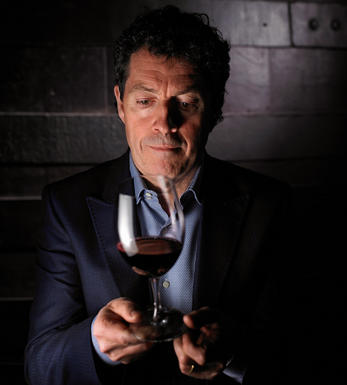
Penfolds
Penfolds enjoys an iconic status that few New World producers have achieved. Established in 1844 at the Magill Estate near Adelaide, it laid the foundation for fine wine production in Australia.
The winemaking team is led by the masterful Peter Gago; it has the herculean task of blending the best wines from a multitude of different plots, vineyards and regions to create a consistent and outstanding range of wines. Its flagship wine, Grange, is firmly established as one of the finest red wines in the world.
Under Gago’s stewardship, the Penfolds range has evolved over time. Winemaking has moved away from New World heat and the sort of larger-than-life style that can mask individuality; the contemporary wines instead favour fine balance and typicity for the region or grape.
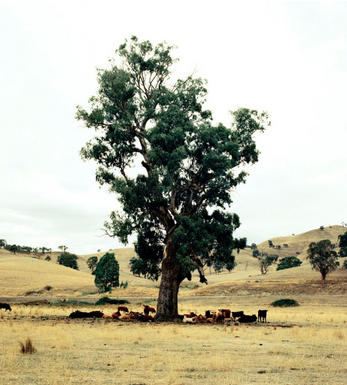
South Australia
At 72,000 hectares, South Australia is the engine room of the country's wine industry, responsible for 43 percent of its vineyards and encompassing some of Australia’s most famous fine wine regions.
One of the most important areas in qualitative terms is the Barossa Valley, beginning 50km north-east of Adelaide, and famous for its full-bodied Shiraz, as well as for its Grenache and Mourvèdre. To the east, the cool Eden Valley is home to some really fine Riesling and top-class Shiraz, such as that made by Henschke. To the north of Barossa is the Clare Valley, also a source of good Riesling but home to well-structured reds as well.
South-east of Adelaide lies the delightful vineyard area of the Adelaide Hills, where fine Sauvignon, Chardonnay, Riesling and Pinot Noir are produced by wineries such as Petaluma and Llangibby Estate. Langhorne Creek to the east of Adelaide has earned a reputation for its Cabernet Sauvignon, Verdelho and Shiraz while, between Adelaide and the sea, McLaren Vale is a noted area for red wines.
The unique vineyard region of Coonawarra lies 400km south-east in an area of pure limestone topped by a loose, red topsoil. Cool enough to resemble Bordeaux, this area produces great Cabernets and Merlots and is much in demand. Slightly to the north and to the west lie the regions of Padthaway and Mount Benson respectively, which enjoy similar success as sources of great white wines, especially Chardonnay. Wrattonbully however is known for its fresh, varietally-pure Cabernet Sauvignon and Merlot.
However it’s the less-distinguished Riverland region that accounts for 50 percent of the state’s wine production.
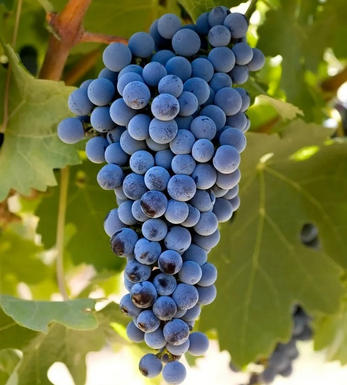
Shiraz & Cabernet Sauvignon
Shiraz/Cabernet (or Cabernet/Shiraz, depending on which is the dominant variety) can be described as Australia's archetypal red wine blend. The blend can trace its roots back to 1865, when the famous Dr Guyot recommended it for the sunbaked vineyards of Provence. It became popular in the early 1960s and 1970s and came about largely due to the high demand for red wines and that fact there there was not enough Cabernet Sauvignon to meet this. At this time Shiraz was widely regarded as inferior to Cabernet Sauvignon and was still being grubbed up in Australian vineyards up until the mid 1980s.
The fleshiness and richness of Australian Shiraz acts as perfect foil for the more tannic and angular Cabernet Sauvignon and the blend is often matured in American oak, which adds notes of vanilla and spice. The proportions in the blend vary from 50/50 to 80/20 in some cases. It is seen across the whole quality spectrum in Australia and the blend is now been used in Languedoc Roussillon in France as well as in South Africa and California.


Buying options
Add to wishlist
Description
The Bin 389 has earnt the nickname of “Baby Grange”, as while the proportion of Shiraz and Merlot in the blend differs, Bin 389 is matured in the oak barrels used for the previous year’s Grange. It is also known to contain declassified fruit from parcels used in Grange and Bin 707.
The 2021 is a blend of 53% Cabernet Sauvignon and 47% Shiraz, a powerful but cooler vintage and one of the most successful Bins this year. It possesses a deliciously complex and layered nose, a plush mid palate bursting with bright, black fruit and oodles of acidity. Sumptuously long and balanced with a clear emphasis on freshness, this is already approachable and will cellar well for 30+ years.
Drink 2025 - 2055
Alex Weller, Account Manager, Berry Bros. & Rudd
wine at a glance
Delivery and quality guarantee